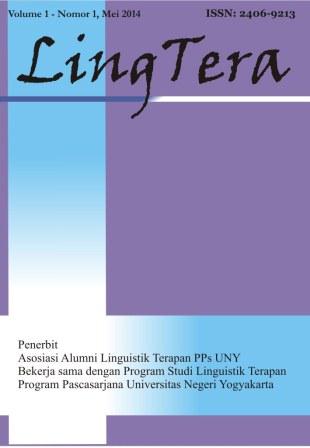Examining English textbook prototype development for vocational high school students
DOI:
https://doi.org/10.21831/lt.v6i2.12683Keywords:
English textbook prototype, VHS students, hotel accommodationAbstract
References
Badan Standar Nasional Pendidikan. (2006). Standar isi untuk satuan pendidikan dasar dan menengah: Standar kompetensi dan kompetensi dasar SMA/MA. Badan Standar Nasional Pendidikan.
Basturkmen, H. (2010). Developing courses in English for specific purposes. Springer.
Berns, R. G., & Erickson, P. M. (2001). Contextual teaching and learning: preparing students for the new economy. The Highlight Zone: Research © Work, 5, 1–9. http://files.eric.ed.gov/fulltext/ED452376.pdf
Billett, S. (2011). Vocational education: Purposes, traditions and prospects. Springer Science & Business Media.
Dick, W., Carey, L., & Carey, J. O. (2009). The systematic design of instruction (8th ed.). Pearson.
Dudley-Evans, T., St John, M. J., & Saint John, M. J. (1998). Developments in English for specific purposes: A multi-disciplinary approach. Cambridge University Press.
Gall, M. D., Gall, J. P., Borg, W. R. D., & Gall, J. P. (2003). Educational research: An introduction (7th ed.). Pearson Education Inc.
Graves, K., & Xu, S. (2000). Designing language courses: A guide for teachers. Heinle & Heinle Boston, MA.
Harmer, J. (1991). The practice of English language teaching. Longman.
Huchinson, T., & Waters, A. (1987). English for Specific Purposes: A learning-centered approach. Cambridge.
Hutchinson, T., & Waters, A. (1994). English for specific purposes: A learning-centred approach. Cambridge University Press.
Hyland, K. (2006). English for academic purposes: An advanced resource book. Routledge.
Kuijpers, M., & Meijers, F. (2012). Learning for now or later? Career competencies among students in higher vocational education in the Netherlands. Studies in Higher Education, 37(4), 449–467. https://doi.org/10.1080/03075079.2010.523144
Kunter, M., Klusmann, U., Baumert, J., Richter, D., Voss, T., & Hachfeld, A. (2013). Professional competence of teachers: Effects on instructional quality and student development. Journal of Educational Psychology, 105(3), 805–820. https://doi.org/10.1037/a0032583
McDonough, J., Shaw, C., & Masuhara, H. (2012). Materials and methods in ELT : a teacher's guide. Wiley-Blackwell. https://www.wiley.com/en-id/Materials+and+Methods+in+ELT:+A+Teacher's+Guide,+3rd+Edition-p-9781444336924
Miles, M. B., Huberman, A. M., & Saldaña, J. (2014). Qualitative data analysis: A methods sourcebook. Sage.
Nation, I. S. P., & Macalister, J. (2010). Language curriculum design. Routledge.
Nunan, D. (1988). Principles for designing language teaching materials. In Guidelines: A Periodical for Classroom Language Teachers (Vol. 10, Issue 2, pp. 1–24). https://stanford.idm.oclc.org/login?url=https://search.ebscohost.com/login.aspx?direct=true&db=eric&AN=EJ468940&site=ehost-live&scope=site
Nunan, D. (2004). Task-based language teaching. Cambridge University Press. https://doi.org/10.1017/cbo9780511667336
Peraturan Pemerintah Republik Indonesia no 19 th 2005 tentang Standar Nasional Pendidikan, Pub. L. No. 19 (2005).
Rahayuningsih, R. S., Fajaruddin, S., & Manggalasari, L. C. (2018). The implementation of total quality management in vocational high schools. Psychology, Evaluation, and Technology in Educational Research, 1(1), 31–40. https://doi.org/10.33292/petier.v1i1.20
Renandya, W. A., & Jacobs, G. M. (1998). Learners and language learning. SEAMEO Regional Language Centre.
Richards, J. C. (2001). Curriculum development in language teaching. Cambridge University Press. https://doi.org/10.1017/cbo9780511667220
Richards, J. C., & Rodgers, T. S. (2014). Approaches and methods in language teaching. Cambridge University Press.
Saragih, E. (2014). Designing ESP materials for nursing students based on need analysis. International Journal of Linguistics, 6(4), 59. https://doi.org/10.5296/ijl.v6i4.5983
Tomlinson, B. (2011). Materials development in language teaching. Cambridge University Press.
Zelloth, H. (2014). Technical and Vocational Education and Training (TVET) and career guidance: The interface. In Handbook of Career Development (pp. 271–290). Springer. https://doi.org/10.1007/978-1-4614-9460-7_15
Downloads
Published
How to Cite
Issue
Section
Citation Check
License
LingTera allows readers to read, download, copy, distribute, print, search, or link to its articles' full texts and allows readers to use them for any other lawful purpose. The journal allows the author(s) to hold the copyright without restrictions. Finally, the journal allows the author(s) to retain publishing rights without restrictions.
- Authors are allowed to archive their submitted articles in an open-access repository.
- Authors are allowed to archive the final published article in an open-access repository with an acknowledgment of its initial publication in this journal.

Psychology, Evaluation, and Technology in Educational Research is licensed under a Creative Commons Attribution-ShareAlike 4.0 International License.
Based on a work at https://petier.org/index.php/PETIER.










